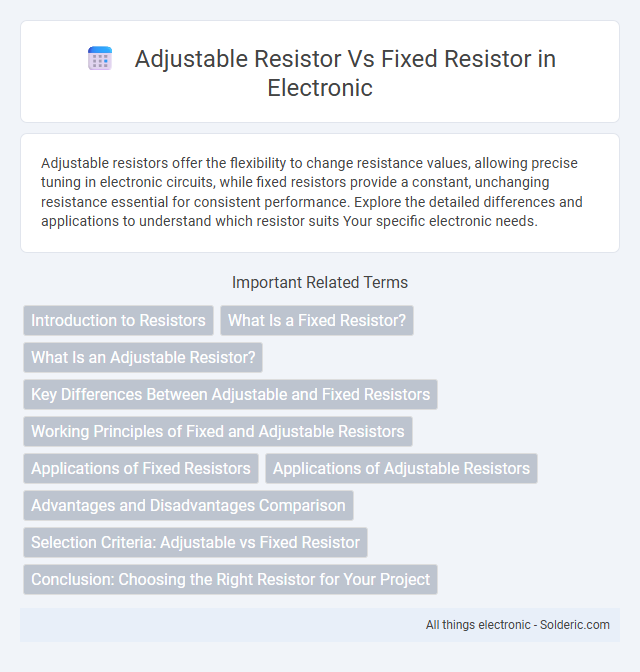Adjustable resistors offer the flexibility to change resistance values, allowing precise tuning in electronic circuits, while fixed resistors provide a constant, unchanging resistance essential for consistent performance. Explore the detailed differences and applications to understand which resistor suits Your specific electronic needs.
Comparison Table
| Feature | Adjustable Resistor | Fixed Resistor |
|---|---|---|
| Definition | Resistor with variable resistance, adjustable manually | Resistor with constant, non-changeable resistance value |
| Resistance Value | Variable, typically via a dial or slider (e.g., potentiometer) | Fixed, specified by manufacturer (e.g., 1 kO) |
| Usage | Calibration, tuning circuits, volume controls | Setting fixed current or voltage in circuits |
| Precision | Lower precision due to manual adjustment | High precision, stable resistance |
| Cost | Generally more costly due to mechanical parts | Less expensive and widely produced |
| Applications | Variable gain amplifiers, sensor calibration, tuning circuits | Fixed biasing, load setting, voltage division |
Introduction to Resistors
Resistors, fundamental components in electrical circuits, regulate current flow by providing a specific resistance value measured in ohms. Fixed resistors offer a constant, unchanging resistance ideal for stable, predictable circuit conditions, while adjustable resistors, such as potentiometers or rheostats, allow you to modify resistance dynamically to fine-tune circuit performance. Understanding the differences helps optimize your electronic designs for precision and flexibility.
What Is a Fixed Resistor?
A fixed resistor is an electronic component that provides a constant resistance value in a circuit, designed to limit current flow or divide voltage. Unlike adjustable resistors, fixed resistors have a precisely specified resistance that cannot be altered after manufacturing. Common types include carbon film, metal oxide, and wirewound resistors, each offering stability and reliability for various applications like signal conditioning and circuit protection.
What Is an Adjustable Resistor?
An adjustable resistor, also known as a potentiometer or rheostat, allows you to vary resistance within a circuit dynamically, enabling precise control of current and voltage. Unlike fixed resistors with a constant resistance value, adjustable resistors feature a movable wiper or slider that adjusts the resistance in real-time. This flexibility makes them ideal for tuning and calibration tasks in electronics, such as volume control or sensor calibration.
Key Differences Between Adjustable and Fixed Resistors
Adjustable resistors, such as potentiometers and rheostats, offer variable resistance values that can be fine-tuned during operation, whereas fixed resistors provide a constant resistance that remains unchanged. Fixed resistors are typically used for precise, stable resistance requirements in circuits, while adjustable resistors enable calibration and control of voltage or current. The key difference lies in their functionality: adjustable resistors allow for dynamic adjustment, making them ideal for applications needing flexibility, whereas fixed resistors are essential for consistent, reliable resistance in electronic components.
Working Principles of Fixed and Adjustable Resistors
Fixed resistors operate by maintaining a constant resistance value determined by the material composition and physical dimensions of the resistive element, ensuring stable current flow in a circuit. Adjustable resistors, such as potentiometers or rheostats, change resistance through a movable wiper or slider that alters the effective length of the resistive path, allowing dynamic control of current or voltage. Both types rely on Ohm's law, but adjustable resistors provide versatility in tuning circuit parameters while fixed resistors deliver consistent, precise resistance.
Applications of Fixed Resistors
Fixed resistors are widely used in electronic circuits for precise control of current and voltage, ensuring stability in power supply designs and signal processing units. Common applications include setting bias currents in transistors, dividing voltages in voltage divider circuits, and limiting current in LED circuits to protect components from damage. Their reliable resistance values make them essential in fixed filtering networks, timing circuits, and as load resistors in various analog and digital devices.
Applications of Adjustable Resistors
Adjustable resistors, also known as potentiometers or rheostats, are widely used in applications requiring variable resistance for fine-tuning electrical parameters such as volume control in audio devices, light dimmers, and sensor calibration circuits. Unlike fixed resistors, adjustable resistors provide flexibility to optimize circuit performance in real-time, making them essential in prototyping and adjustable power supplies. Your ability to modify resistance without replacing components enhances the versatility and precision of electronic designs.
Advantages and Disadvantages Comparison
Adjustable resistors offer the advantage of fine-tuning resistance values in circuits, providing flexibility for calibration and testing, while fixed resistors provide stable, precise resistance with consistent performance over time. Adjustable resistors may introduce noise and have limited power ratings, which could affect circuit reliability, whereas fixed resistors typically have lower cost and higher durability under varying environmental conditions. Choosing between adjustable and fixed resistors depends on the application's need for precision adjustment versus long-term stability and cost efficiency.
Selection Criteria: Adjustable vs Fixed Resistor
Selection criteria for adjustable vs fixed resistors depend on the need for precision and flexibility in circuit design. Adjustable resistors allow you to fine-tune resistance values during testing or calibration, making them ideal for applications requiring variability or customization. Fixed resistors provide stable, predefined resistance values, ensuring consistent performance in circuits where reliability and simplicity are crucial.
Conclusion: Choosing the Right Resistor for Your Project
Selecting the right resistor depends on the project's specific needs for precision and flexibility. Adjustable resistors offer tunable resistance values ideal for calibration and prototyping, while fixed resistors provide stable, consistent resistance suited for long-term, unchanging circuits. Understanding circuit requirements and performance criteria ensures optimal resistor choice for efficiency and reliability.
Adjustable resistor vs fixed resistor Infographic

 solderic.com
solderic.com